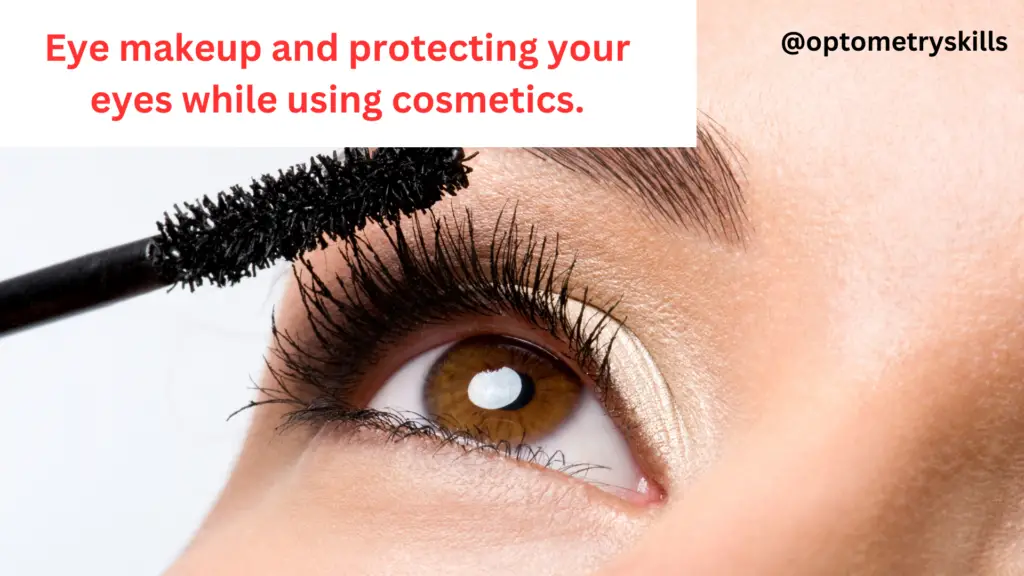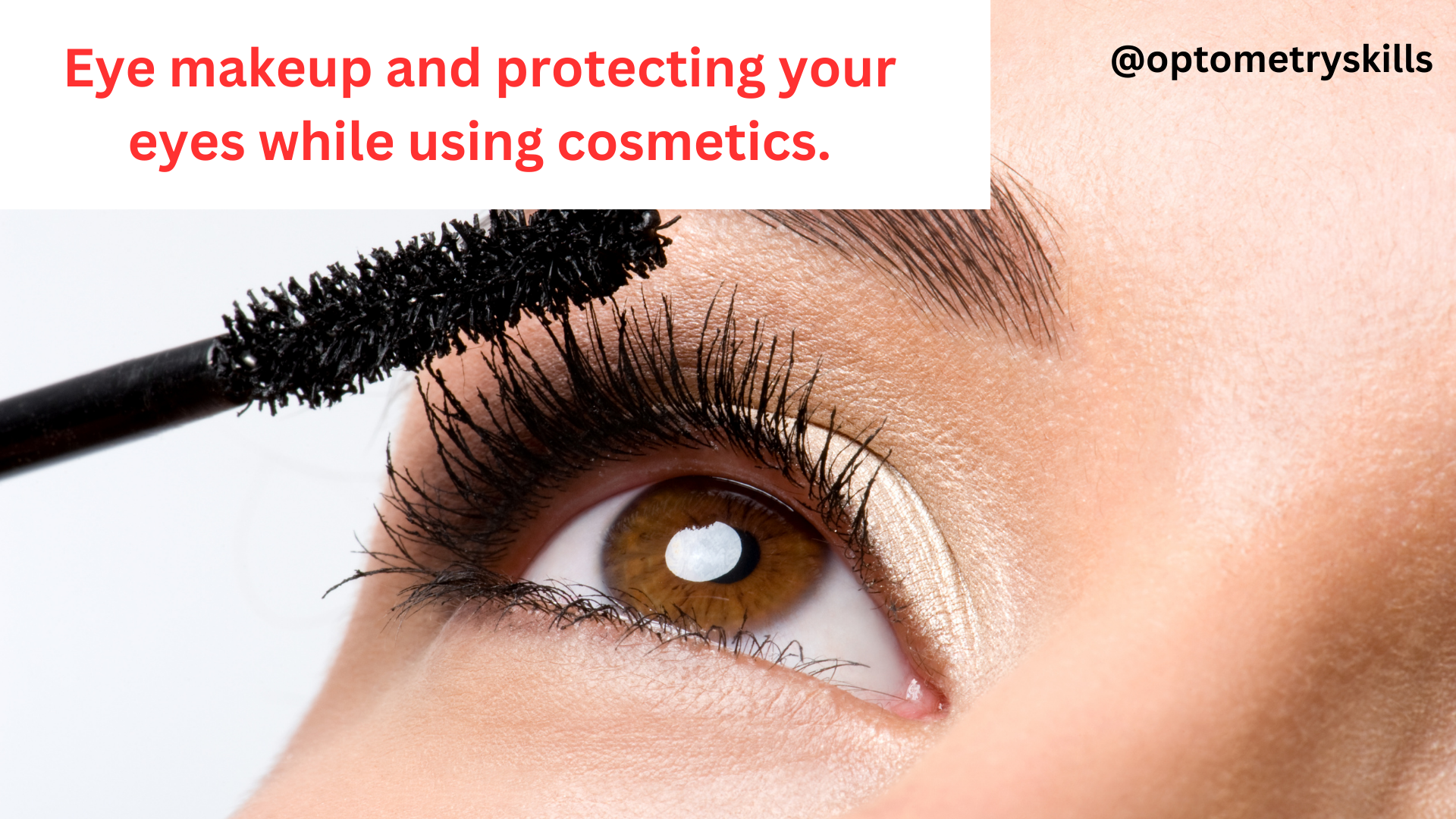Protecting Your Eyes While Using Cosmetics: Safe Practices
As eye care professionals, we often focus on vision correction and the prevention of common eye diseases, but we must also pay attention to everyday habits and products that can impact eye health. One such area of concern is the use of cosmetics, particularly eye makeup, which many people apply regularly as part of their grooming routine. However, it’s important to understand that some of these cosmetics can pose serious risks to the delicate structures of the eye. The good news is that with the right knowledge and precautions, we can safely enjoy makeup without compromising eye health.
Understanding the Risks of Eye Makeup-Protecting Your Eyes While Using Cosmetics
Recent studies have given us important insights into the potential dangers of eye makeup. A notable study from the University of Waterloo found that makeup particles move more quickly into the tear film when eyeliner is applied to the inner lid margin—right along the lash line. In fact, the study found that within just five minutes of application, 15-30% more makeup particles moved into the eye compared to when eyeliner was applied outside the lash line. This simple action of applying eyeliner inside the lash line accelerates the migration of makeup into the eye, increasing the risk of ocular complications.

But makeup migration is not the only concern. Different types of cosmetics can have varying effects on the eyes. Let’s dive deeper into how common cosmetics impact eye health:
The Specific Impact of Different Cosmetics on the Eyes
1. Eyeliner
Eyeliner is one of the most commonly used cosmetics, but its application carries several risks. As mentioned earlier, applying eyeliner directly to the inner lash line significantly increases the risk of makeup particles migrating into the eye’s tear film. This can lead to dryness, irritation, or infection. Moreover, certain eyeliners, particularly those containing heavy metals such as cadmium, have been shown to cause damage to the cornea, leading to endothelial cell degeneration. This disrupts the corneal pump function and can ultimately affect vision. Eyeliner also tends to get into the eyes more quickly if it’s applied heavily, especially if it smudges or flakes off throughout the day.
2. Mascara
Mascara is another product that can impact eye health in various ways. The wand can cause mechanical trauma to the eye, particularly if it’s inserted or removed carelessly. This type of injury opens the door for bacteria to enter the eye, potentially leading to infections. Additionally, mascara can contribute to dry eyes, particularly when applied too thickly or left on overnight. Mascara can also build up on the eyelashes, making it harder to clean the lashes thoroughly, which increases the risk of irritation and potential bacterial growth. For individuals who wear contact lenses, mascara can bind to the lens surface, making them uncomfortable and potentially causing scratches or further irritation.
Heavy use of mascara has also been linked to potential blockages in the lacrimal system (the tear drainage system), particularly with excessive use or improper removal. This can lead to watery eyes or difficulty with tear drainage, especially for individuals with pre-existing dry eye conditions.
3. Eyeshadow
While eyeshadow is generally less likely to cause severe damage to the eyes compared to other products, it can still pose risks, particularly when particles from the eyeshadow migrate into the tear film. Loose powder eyeshadows are more likely to flake and get into the eyes, which can cause irritation, particularly for individuals with dry or sensitive eyes. Additionally, some eyeshadows contain ingredients that may cause allergic reactions, such as preservatives, dyes, and fragrances. Regular use of eyeshadows, especially those with metallic or glitter components, can also contribute to pigmentation changes in the skin and conjunctiva, which may lead to a darkening of the area around the eyes over time.
4. Eyebrow Products
Brow pencils, gels, and powders are generally applied in close proximity to the eye, and while they aren’t typically applied directly onto the eyelid, they can still affect eye health. The area around the eyes is delicate, and many eyebrow products contain ingredients that can clog pores or cause skin irritation. If any product makes contact with the eye, it can lead to stinging, redness, or an allergic reaction. Moreover, certain eyebrow products, especially those containing harsh chemicals or preservatives, can cause irritation if accidentally rubbed into the eye, leading to symptoms of conjunctivitis or blepharitis.
5. Waterproof Cosmetics
Waterproof mascara and eyeliner are popular because they resist smudging throughout the day, but they come with their own set of risks. These products tend to be more difficult to remove and may leave behind stubborn particles that can irritate the eyes. Furthermore, some waterproof formulas contain ingredients that can destabilize the tear film, causing dryness and irritation, particularly for individuals with dry eye disease or those who wear contact lenses. In addition, the use of waterproof makeup removers—which often contain surfactants—can cause further disruption to the tear film, affecting the eye’s natural ability to maintain moisture.
6. Cosmetic Contact Lenses
Cosmetic contact lenses—such as those with colored tints or designs for aesthetic purposes—are increasingly popular but pose significant risks to eye health. These lenses can disrupt the natural tear film, leading to dryness, irritation, and blurred vision. Furthermore, if not properly cleaned or fitted, they can introduce bacteria into the eye, potentially leading to eye infections such as keratitis. If not properly maintained, cosmetic contact lenses can also cause corneal abrasions or contribute to an increase in eye pressure, which is particularly concerning for individuals with glaucoma.
How to Protect Your Eyes while using cosmetics
While the risks associated with eye makeup are real, they are not insurmountable. By adopting a few simple habits, we can significantly reduce the chances of eye irritation, infection, and long-term damage from various cosmetics.
1. Apply Makeup Outside the Lash Line
To minimize the migration of makeup particles into the eye, try to avoid applying eyeliner directly on the inner lash line. Stick to the outer part of the lash line to keep makeup away from the tear film and reduce the likelihood of particles entering the eye.
2. Don’t Share Your Makeup
Sharing makeup products, especially eye cosmetics, is a fast track to contamination. Even when makeup is stored properly, it can still harbor harmful bacteria. If you must share, make sure to use disposable applicators and never double-dip into products.
3. Replace Your Cosmetics Regularly
Makeup products, particularly those used around the eyes, should be replaced every three to six months to avoid bacterial buildup. If a product has changed in smell, texture, or color, it’s time to dispose of it. Regular replacement will help reduce the risk of infections and irritations.
4. Remove Makeup Gently
When removing eye makeup, be sure to use a gentle, ophthalmologist-approved makeup remover. Avoid rubbing or pulling on the skin around your eyes, as this can lead to irritation and even damage to the delicate skin in the area.
5. Choose Safe Cosmetics
Look for products labeled as “ophthalmologist-tested” or “safe for sensitive eyes.” These products are less likely to cause irritation or allergic reactions. Avoid products that contain harsh chemicals or fragrances, as they can be irritating to the eyes and surrounding skin.
6. Avoid Waterproof Formulas if You Wear Contact Lenses
Waterproof mascaras and eyeliners are notorious for binding to contact lenses, making them uncomfortable to wear. If you wear contact lenses, opt for non-waterproof formulas and be diligent about removing all makeup before inserting or removing your lenses.
7. Consult Your Optometrist
If you experience discomfort, dryness, or irritation after using makeup, it’s important to consult with your optometrist. They can recommend suitable products or treatments to alleviate symptoms and help you protect your eye health in the future.
Find Alternatives
Here are some additional alternatives to consider for protecting your eyes:
- Use Thicker Mascara: Choose a thickening mascara rather than one meant for lengthening or waterproof formulas. These are less likely to flake and get into the eyes.
- Plastic Eyelash Curlers: Consider using a plastic eyelash curler as a great alternative to metal curlers, which can cause irritation and dryness around the eyes.
- Highlight Other Features: If you suffer from severe or chronic dry eye, or are intolerant of eye makeup, consider highlighting other features of your face, such as your lips and cheeks, instead of your eyes. This way, you can still enhance your beauty without touching your eyes.
Follow our Optometry Page for more eye care tips.
Discover more from An Eye Care Blog
Subscribe to get the latest posts sent to your email.


You must be logged in to post a comment.